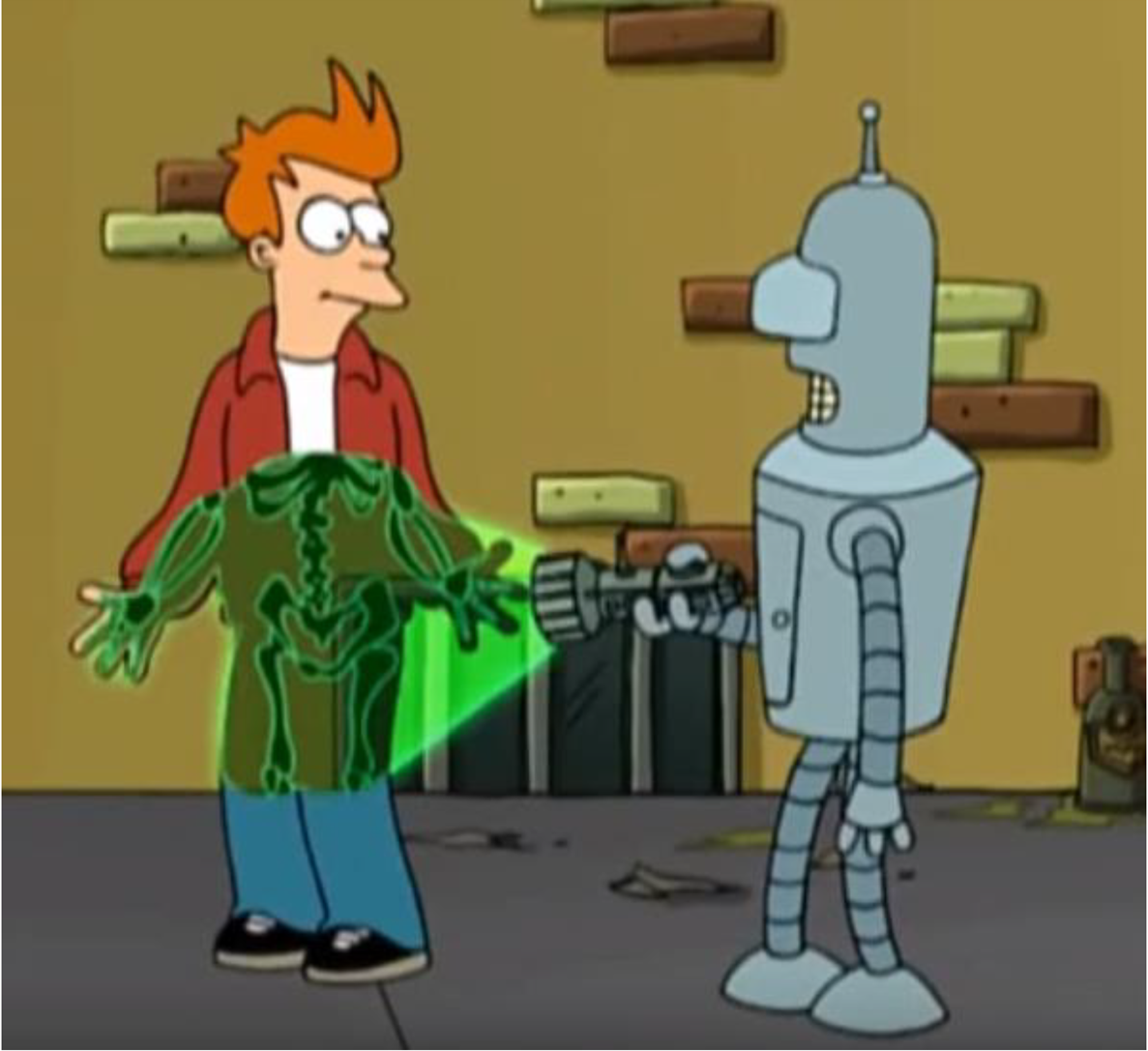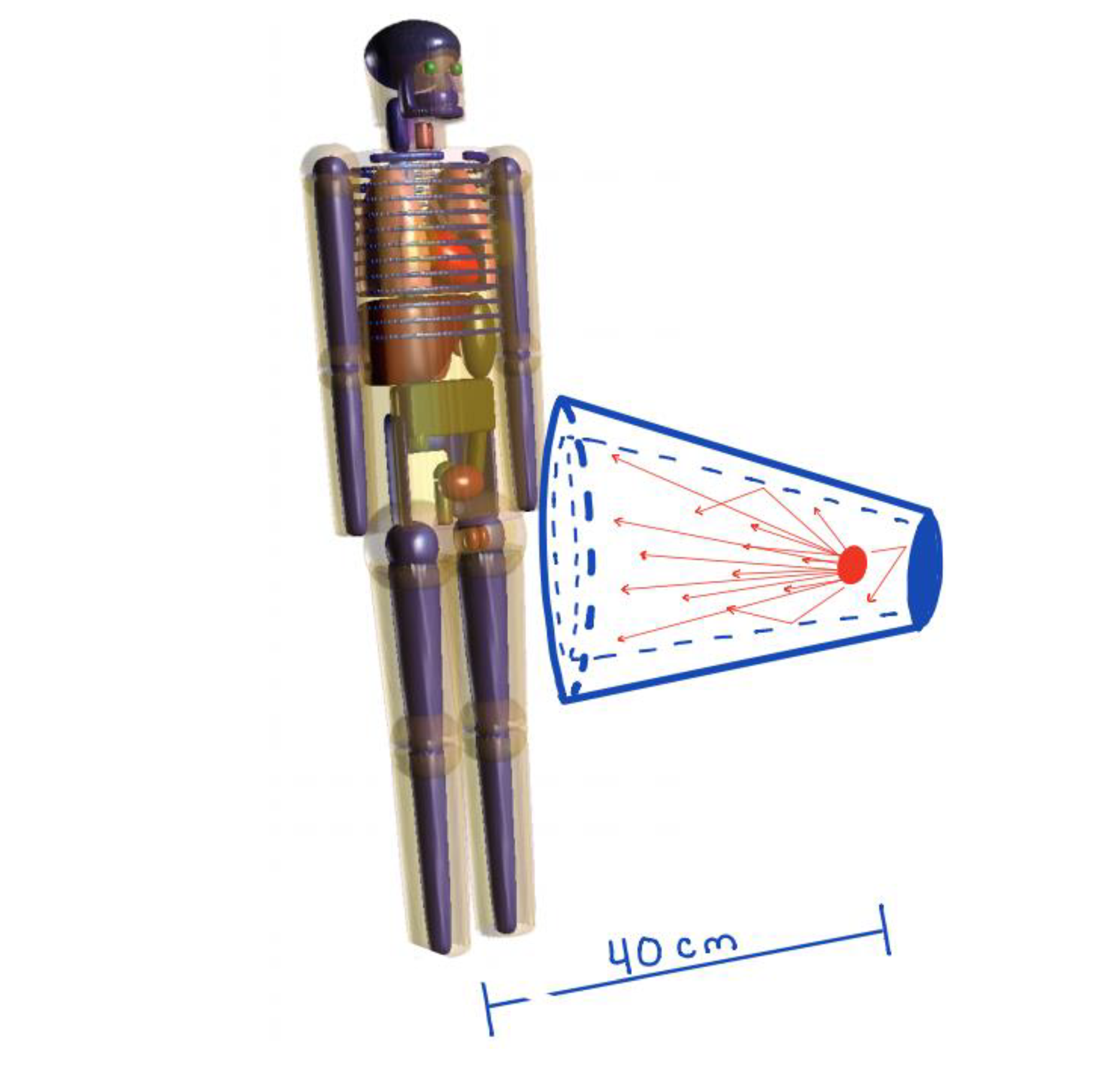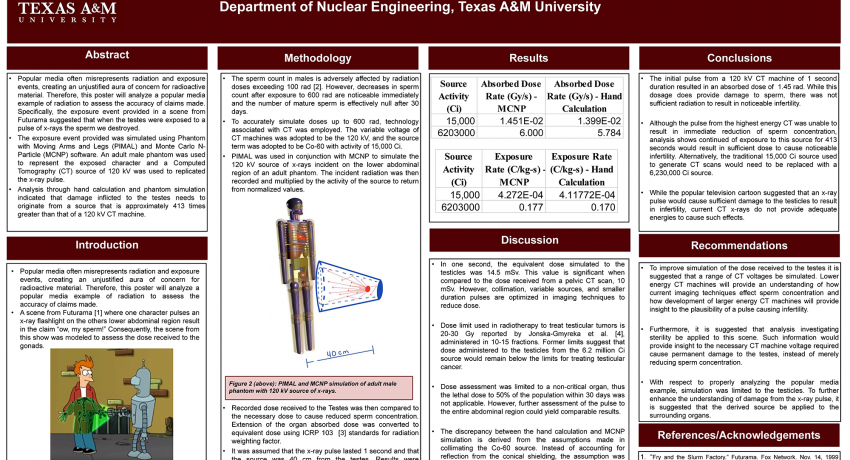Poster
Chase Foreman, Alexander Perry
Department of Nuclear Engineering, Texas A&M University
Abstract
- Popular media often misrepresents radiation and exposure events, creating an unjustified aura of concern for radioactive material. Therefore, this poster will analyze a popular media example of radiation to assess the accuracy of claims made. Specifically, the exposure event provided in a scene from Futurama suggested that when the testes were exposed to a pulse of X-rays the sperm were destroyed.
- The exposure event provided was simulated using the Phantom with Moving Arms and Legs (PIMAL) and Monte Carlo N- Particle (MCNP) software. An adult male phantom was used to represent the exposed character and a Computed Tomography (CT) source of 120 kV was used to replicate the X-ray pulse.
- Analysis through hand calculation and phantom simulation indicated that damage inflicted to the testes needs to originate from a source that is approximately 413 times greater than that of a 120 kV CT machine.
Introduction
- Popular media often misrepresents radiation and exposure events, creating an unjustified aura of concern for radioactive material. Therefore, this poster will analyze a popular media example of radiation to assess the accuracy of claims made.
- A scene from Futurama [1] where one character pulses an X-ray flashlight on the other lower abdominal region results in the claim “ow, my sperm!” Consequently, the scene from this show was modeled to assess the dose received to the gonads.

Figure 1 (above): Futurama X-ray exposure event - The statement made after exposure to an apparently high energy X-ray beam suggests that the gonads were subject to doses that resulted in reduced fertility. Therefore, it is suggested that the simulation assess X-ray energy that results in a sufficiently high dose.
Methodology
- The sperm count in males is adversely affected by radiation doses exceeding 100 rad [2]. However, decreases in sperm count after exposure to 600 rad are noticeable immediately and the number of mature sperm is effectively null after 30 days.
- To accurately simulate doses up to 600 rad, technology associated with CT was employed. The variable voltage of CT machines was adopted to be the 120 kV, and the source term was adopted to be Co-60 with activity of 15,000 Ci.
- PIMAL was used in conjunction with MCNP to simulate the 120 kV source of X-rays incident on the lower abdominal region of an adult phantom. The incident radiation was then recorded and multiplied by the activity of the source to return from normalized values.

Figure 2 (above): PIMAL and MCNP simulation of the adult male phantom with 120 kV source of X-rays. - The recorded dose received to the testes was then compared to the necessary dose to cause reduced sperm concentration. Extension of the organ absorbed dose was converted to equivalent dose using ICRP 103 [3] standards for radiation weighting factor.
- It was assumed that the X-ray pulse lasted 1 second and that the source was 40 cm from the testes. Results were compared to an approximated hand calculation using the equations provided below.

Results
|
Source |
Absorbed Dose |
Absorbed Dose |
|
15,000 |
1.451E-02 |
1.399E-02 |
|
6,203,000 |
6.000 |
5.784 |
|
Source Activity |
Exposure Rate (C/kg-s) - |
Exposure Rate (C/kg-s) - Hand |
|
15,000 |
4.272E-04 |
4.11772E-04 |
|
6,203,000 |
0.177 |
0.170 |
Discussion
- In one second, the equivalent dose simulated to the testicles was 14.5 mSv. This value is significant when compared to the dose received from a pelvic CT scan, 10 mSv. However, collimation, variable sources, and smaller duration pulses are optimized in imaging techniques to reduce the dose.
- The dose limit used in radiotherapy to treat testicular tumors is 20-30 Gy reported by Jonska-Gmyreka et al. [4], administered in 10-15 fractions. Former limits suggest that doses administered to the testicles from the 6.2 million Ci source would remain below the limits for treating testicular cancer.
- Dose assessment was limited to a non-critical organ, thus the lethal dose to 50% of the population within 30 days was not applicable. However, further assessment of the pulse to the entire abdominal region could yield comparable results.
- The discrepancy between the hand calculation and MCNP simulation is derived from the assumptions made in collimating the Co-60 source. Instead of accounting for reflection from the conical shielding, the assumption was made that an isotropic source was placed, unshielded, next to the phantom. This assumption in the hand calculation neglected photons that would have otherwise reflected from the conical stainless-steel collimator toward the target area.
Conclusions
- The initial pulse from a 120 kV CT machine of 1-second duration resulted in an absorbed dose of 1.45 rad. While this dosage does provide damage to sperm, there was not sufficient radiation to result in noticeable infertility.
- Although the pulse from the highest energy CT was unable to result in an immediate reduction of sperm concentration, analysis shows continued exposure to this source for 413 seconds would result in a sufficient dose to cause noticeable infertility. Alternatively, the traditional 15,000 Ci source used to generate CT scans would need to be replaced with a 6,230,000 Ci source.
- While the popular television cartoon suggested that an X-ray pulse would cause sufficient damage to the testicles to result in infertility, current CT X-rays do not provide adequate energies to cause such effects.
Recommendations
- To improve the simulation of the dose received to the testes it is suggested that a range of CT voltages be simulated. Lower energy CT machines will provide an understanding of how current imaging techniques affect sperm concentration and how the development of larger energy CT machines will provide insight into the plausibility of a pulse causing infertility.
- Furthermore, it is suggested that an analysis investigating sterility be applied to this scene. Such information would provide insight into the necessary CT machine voltage required to cause permanent damage to the testes, instead of merely reducing sperm concentration.
- With respect to properly analyzing the popular media example, the simulation was limited to the testicles. To further enhance the understanding of damage from the X-ray pulse, it is suggested that the derived source be applied to the surrounding organs.
References/Acknowledgements
- “Fry and the Slurm Factory.” Futurama. Fox Network. Nov. 14, 1999 (Television)
- Mavis J Rowley, David R. Leach, Glenn A. Warner, and Carl G. Heller. “Effect of Graded Doses of Ionizing Radiation on the Human Testis.” Radiation Research Society (Spet., 1974)
- International Commission on Radiological Protection. The 2007 Recommendations of the International Commission on Radiological Protection. ICRP Publication 10 2007
- Joanna Jonska-Gmyreka et al. “Radiotherapy in Testicular Germ Cell Tumors.” Contemporary Oncology (2017)
Authors
 Chase Foreman is originally from San Antonio, TX, and is pursuing his Doctorate in Medical Physics at UT Health Science Center in San Antonio. He completed his Bachelor’s of Science in Nuclear Engineering and minor in Radiological Health Engineering at Texas A&M University in May of 2019.
Chase Foreman is originally from San Antonio, TX, and is pursuing his Doctorate in Medical Physics at UT Health Science Center in San Antonio. He completed his Bachelor’s of Science in Nuclear Engineering and minor in Radiological Health Engineering at Texas A&M University in May of 2019.
 Alexander Perry recently graduated with a B.S. in Nuclear Engineering from Texas A&M University. He will be starting a direct Ph.D. this Fall at Texas A&M with an emphasis in Computations and Health Physics. His goal is to pursue a research career where he can continue to investigate the advancement of medical applications. He hopes to travel often with his career but wishes to eventually return to his hometown of Dallas, Texas.
Alexander Perry recently graduated with a B.S. in Nuclear Engineering from Texas A&M University. He will be starting a direct Ph.D. this Fall at Texas A&M with an emphasis in Computations and Health Physics. His goal is to pursue a research career where he can continue to investigate the advancement of medical applications. He hopes to travel often with his career but wishes to eventually return to his hometown of Dallas, Texas.
- Log in to post comments

